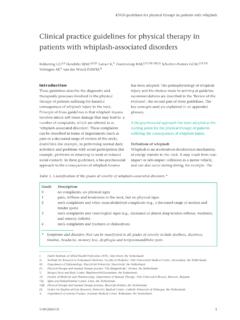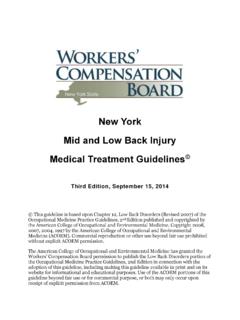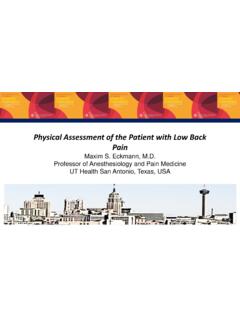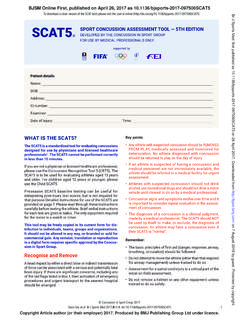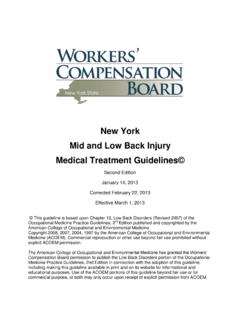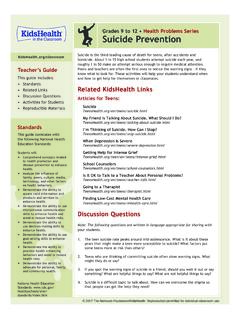Transcription of International Framework for Red Flags for ... - IFOMPT
1 International Framework FOR RED Flags FOR POTENTIAL SERIOUS SPINAL PATHOLOGIES Finucane L, Downie A, Mercer C, Greenhalgh S, Boissonnault WG, Pool-Goudzwaard A, Beneciuk J, Leech R, Selfe J. Authors affiliations Finucane L Sussex MSK Partnership, Brighton, UK Downie A Dept of Chiropractic, Faculty of Science and Engineering, Macquarie University, Australia. Institute for Musculoskeletal Health, Sydney School of Public Health, The University of Sydney, Australia. Mercer C Western Sussex Hospitals NHS Trust, Chichester, UK Greenhalgh S Bolton NHS FT & Dept of Health Professions, Manchester Metropolitan University, UK Boissonnault WG American Physical Therapy Association, Alexandria, VA USA Pool- Goudzwaard AL Department of Behaviour and Movement Sciences, VU University, Amsterdam Movement Sciences, The Netherlands Beneciuk J Dept of Physical Therapy, University of Florida, Gainesville FL, USA.
2 Brooks Rehabilitation, Jacksonville, FL, USA Leech R Dept of Health Professions, Manchester Metropolitan University, UK Selfe J Dept of Health Professions, Manchester Metropolitan University, UK & Physiotherapy Dept, Satakunta University of Applied Sciences, Pori, Finland Endorsement: This clinical Framework for identifying red Flags for serious spinal pathologies is endorsed by the International Federation of Orthopaedic Manipulative Physical Therapists ( IFOMPT ) a subgroup of the World Confederation for Physical Therapists (WCPT) March 2020 i March 2020 Preface Identifying serious pathology as a cause of a person s musculoskeletal presentation is complex. The use of red Flags has historically been used to help clinicians with identification of serious spinal pathology and the majority of guidelines endorse their use. However, there is often variability in guidelines about which red Flags should be considered when examining people seeking care for musculoskeletal disorders.
3 This has led to confusion and inconsistency in the management of people with suspicion of serious pathology, and in some cases, to unnecessary and worrying medical tests, or false reassurance that there is no serious pathology. This document aims to provide clinicians with a more standardised and consistent approach to identifying people with potential serious pathology. The Framework has been developed by researchers and clinicians to provide a pragmatic approach for clinicians to screen for serious pathology that can masquerade as musculoskeletal spinal conditions. The Framework has been informed by available evidence and augmented by a formal consensus process that included academics and clinicians involved in the management of musculoskeletal conditions. This Framework aims to support a variety of health professionals, irrespective of experience, who provide care for people with musculoskeletal spinal conditions.
4 Clinicians working in musculoskeletal services can play an important role in early identification of serious pathology ensuring that people achieve the best possible outcome. The prevalence of serious pathology will vary depending on where the clinician sits within the persons care journey. Spinal surgeons are likely to see more cases of serious pathology than a General Practitioner (GP), and physiotherapists will probably see a number in between the two, depending where on the clinical pathway they work. Those therapists working at an advanced practice level are likely to see more serious pathology as the populations they serve are likely to be more complex. Clinicians will be required to consider the context within which red Flags exist and clinically reason the relevance of the information gathered to determine if any action is required. Person Centred Care Working with people with possible serious pathology can be challenging for both the individual and clinician involved therefore a collaborative approach is essential.
5 A possible diagnosis of serious pathology can be extremely worrying for people, their families and carers. People must be involved in decision making about their care even when faced with a serious diagnosis. Shared decision making is essential to ensure that individuals are supported to make decisions that are right for them. Using a collaborative process, the clinician should highlight the treatment options, evidence, risks and benefits and together with the person understand how these fit with that persons individual circumstances, goals, values and beliefs (NHS England 2020). ii March 2020 Experts by Experience - Feedback on the use of this Framework Clear and open communication with people with potential serious pathology is vital. People presenting with spinal pain may have no concept that this may affect their bladder or bowel function, or that the spinal pain could be caused by serious pathologies such as infection or malignancy.
6 Providing context as to why you are asking the questions being proposed in the Framework is an important aspect of the consultation as some of these questions will seem irrelevant to a person who presents with back pain . Effective communication about red Flags is really important. People can become worried before an appointment, especially if they have; seen something worrying on TV or the internet heard a story from a friend experienced medical misdiagnosis Clinicians should provide reassurance about why a patient is being assessed for red Flags especially if they are at a low risk of something sinister. It isn't just the wording of the questions, but also the body language, tone of voice, and mannerisms etc. of the clinician asking the questions. Patients need to feel at ease when answering questions and, not judged intravenous drug use, poor social and environmental factors.
7 Patients should also be given enough time to think through and communicate their answers about something which they may have never considered before their toilet habits and how they may have changed. Clinicians should provide support regarding the emotional impact on the patient of being assessed for potentially life-changing conditions and in some cases being sent for further investigations. When asking about subjects such as previous history of cancer it is particularly important to offer appropriate emotional support and, when needed, signpost patients to additional services which can offer further support. Acknowledgments We would like to thank all the researchers, clinicians and Member Organisation delegates of IFOMPT , for their generosity in giving up their time to review the document, respond to our surveys and take part in the consensus building process.
8 Thanks to Sussex MSK Partnership Patient Partners, Fleur Goff-Beardsley, Abby King and Iris Keppler for their time and contribution. Craig Marshall for input on the graphic designs. We would also like to thank the following for their financial support for the development and dissemination of this Framework Canadian Academy of Manipulative Physical Therapy (CAMPT) 2000 Chartered Society of Physiotherapy (CSP), UK 15000 International Maitland Teachers Association (IMTA) CHF 3000 Musculoskeletal Association of Chartered Physiotherapists (MACP), UK 5000 Private Practitioners Education Fund (PPEF), UK 30000 Swiss Association of Orthopaedic Manipulative Physiotherapy (SVOMP) CHF 500 iii March 2020 Contents Preface Page i Person Centred Care i Experts by Experience - Feedback on the use of this Framework ii Acknowledgements ii Section 1.
9 Background and Methods 1 Background 1 Decision tool for early identification of potential serious spinal pathology 2 Key clinical messages 4 Priority Serious Spinal Pathologies 4 Abbreviations and definitions of terms used in this Framework Document 6 Abbreviations 6 Definitions 6 Method: Haute Autorit de sant (HAS) consensus method 7 Section 2: Cauda Equina Syndrome 9 Literature and International Consensus 9 CES clinical reasoning cases/scenarios 22 Suggested pathway for emergency/ urgent referral 23 Section 3: Spinal Fracture 24 Literature and International Consensus 24 Spinal fracture clinical reasoning cases/scenarios 31 Suggested pathway for emergency/ urgent referral 33 Section 4: Spinal Malignancy 34 Literature and International Consensus 34 Spinal Malignancy clinical reasoning cases/scenarios 41 Suggested pathway for emergency/ urgent onward referral 42 Section 5: Spinal Infection 43 Literature and International Consensus 43 Spinal Infection clinical reasoning cases/scenarios 50 Suggested pathway for emergency/ urgent onward referral 51 References 52 Appendix 1: Key papers, evidence statements 58 Appendix 2: Red Flags which Gained Consensus as Inappropriate 61 iv March 2020 Tables Page Table 1.
10 Prevalence Estimates for Key Pathologies Presenting with back pain 6 Table Number of CES red Flags gaining consensus 9 Table Risk Factors for CES 11 Table Symptoms of CES 14 Table Signs of CES 21 Table Initial Investigations for CES 22 Table Number of spinal fracture red Flags gaining consensus 24 Table Risk Factors for Spinal Fracture 26 Table Symptoms of Spinal Fracture 29 Table Signs of Spinal Fracture 30 Table Initial Investigations for Spinal Fracture 31 Table Number of spinal malignancy red Flags gaining consensus 34 Table Risk Factors for Spinal Malignancy 36 Table Symptoms of Spinal Malignancy 37 Table Signs of Spinal Malignancy 40 Table Initial Investigations for Spinal Malignancy 41 Table Number of spinal infection red Flags gaining consensus 43 Table Risk Factors for Spinal Infection 45 Table Symptoms of Spinal Infection 47 Table Signs of Spinal Infection 49 Table Initial Investigations for Spinal Infection 50 Table : Key papers, evidence statements 58 Table : Red Flags which Gained Consensus as Inappropriate 61 1 March 2020 1: Background and Methods : Background This is an internationally agreed Framework to aid early assessment and initial management of people who present with potential serious spinal pathology.
